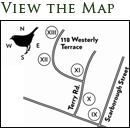Born in 1879 in Reading, Pennsylvania, Wallace Stevens is best known as a resident of Hartford, Connecticut, where he lived for almost forty years, until his death in 1955; he is buried in Cedar Hill Cemetery there. Stevens attended Harvard University in Boston, and in 1904 received a law degree from New York Law School. Stevens worked briefly as a reporter for the New York Tribune, but the exposure to crime and despair proved to be too much for him, and he turned to practicing law.
Stevens married in 1909 and relocated with his wife in 1916 to Hartford. Their first year there, they lived at 594 Prospect Avenue, then spent seven years in an apartment at 210 Farmington Avenue, where Stevens wrote his first volume of poetry, Harmonium. In 1932, Stevens bought a 1920s Colonial at 118 Westerly Terrace, where he amassed a library of leather-bound books, collected art, and kept a wine cellar. He cared for his rose and peony beds, and the holly bush he planted in honor of his daughter, Holly.
For decades, Stevens worked at the Hartford Accident and Indemnity Company, now the Hartford Financial Services Group, Inc., eventually becoming vice president. Because he never learned to drive, walking became a central part of his daily life. He walked the two-mile route every day from his West End home to his office in Asylum Hill. He composed poems in his head while walking and once said that he enjoyed matching the words in his head to the rhythm of his steps. The city of Hartford and its surroundings left a lasting mark on his work, as shown in these lines from "Of Hartford in a Purple Light":
It is Hartford seen in a purple light.
A moment ago, light masculine,
Working, with big hands, on the town,
Arranged its heroic attitudes.
But as in an amour of women
Purple sets purple around. Look Mater,
See the river, the railroad, the cathedral..."
One of Stevens's favorites places to wander in Hartford was Elizabeth Park. With over one hundred acres of gardens, lawns, and greenhouses, and a pond, the park appeared frequently in his poems, including "The Plain Sense of Things" which includes the lines:
Yet the absence of the imagination had
Itself to be imagined. The great pond,
The plain sense of it, without reflection, leaves,
mud, water like dirty glass, expressing silence
In 2009, the Hartford Friends and Enemies of Wallace Stevens completed work on the Wallace Stevens Walk, a 2.4 mile self-guided walking tour that traces the path the poet took each day to and from his Hartford home. Beginning at what was once his workplace and ending at 118 Westerly Terrace, the walk traverses the Asylum Avenue section of Hartford’s Asylum Hill and West End neighborhoods. The course of the Wallace Stevens Walk is marked by thirteen Connecticut granite stones, each uniquely carved and engraved with a stanza from "Thirteen Ways of Looking at a Blackbird," a poem that's among Stevens's most well-known and frequently studied works.

